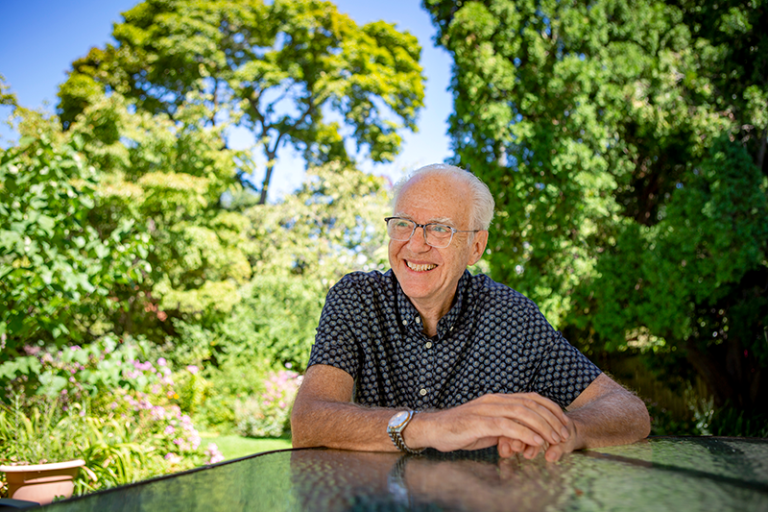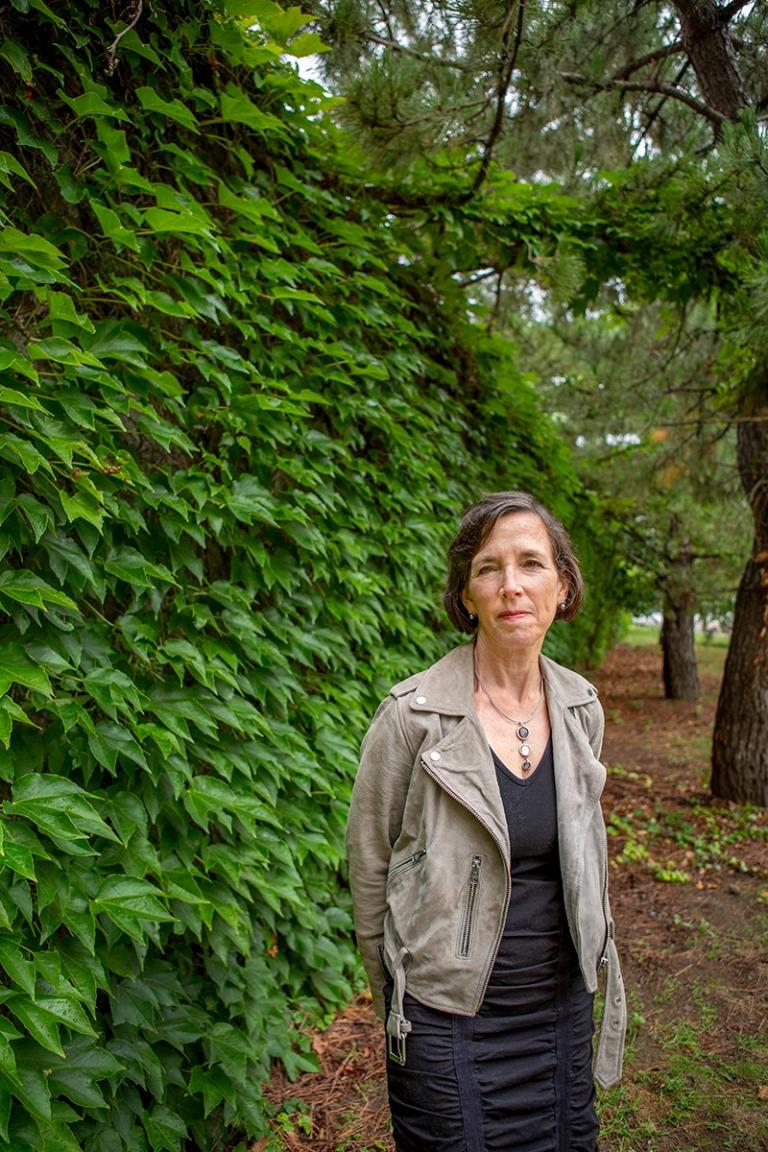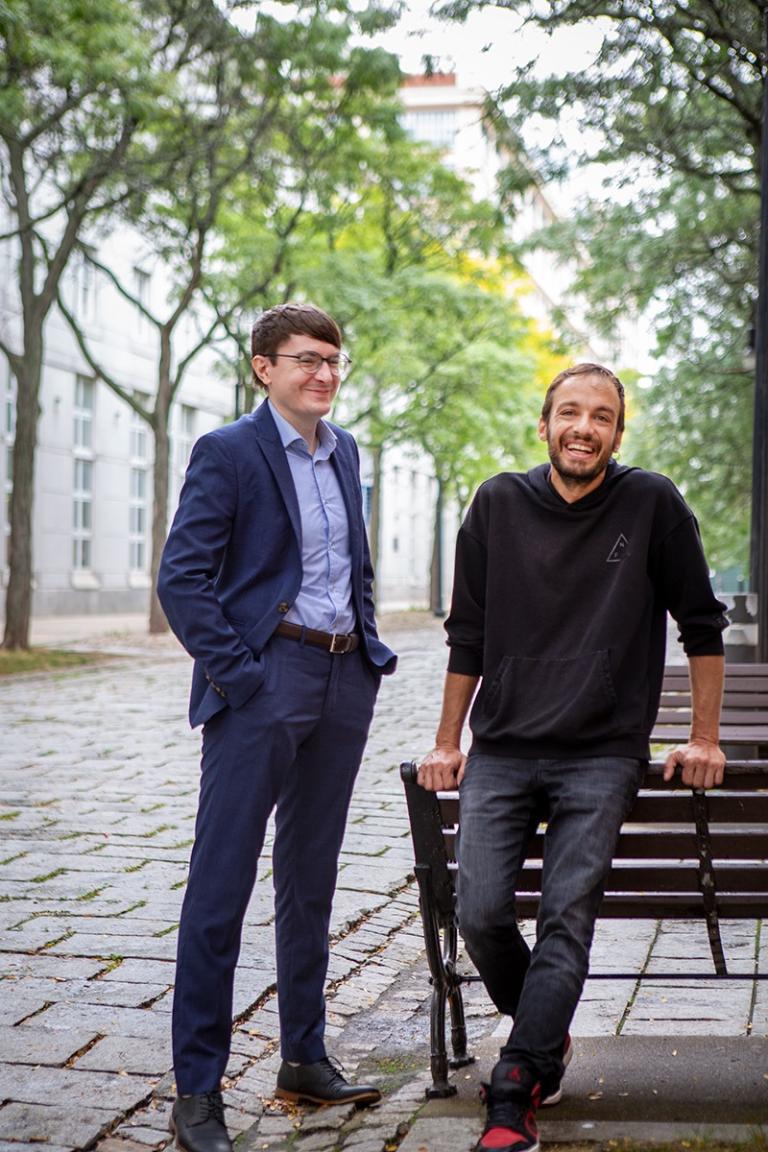Sleep Melds Memories
Researchers home in on how the sleeping brain consolidates memories
- 14 min read
- Feature
The Lagoon Nebula, shown above in a 2018 photograph by the Hubble Space Telescope, lies 4,000 light-years from Earth. It is filled with radiation, high-speed particles, and dense clouds of gases — the stuff that stars are made of. Through an ages-long process of consolidation, stars are built. When ready, they take their places in the celestial expanse.

The Lagoon Nebula, shown above in a 2018 photograph by the Hubble Space Telescope, lies 4,000 light-years from Earth. It is filled with radiation, high-speed particles, and dense clouds of gases — the stuff that stars are made of. Through an ages-long process of consolidation, stars are built. When ready, they take their places in the celestial expanse.
Listen to this story
J. Allan Hobson, MD ’59, used to say that the only known biological function of sleep was to cure sleepiness. It was the only biological drive that humanity didn’t yet understand the purpose of. Hunger and thirst propel people to sustain their bodies; sex perpetuates the species. But sleep? Nothing.
Then his team found evidence of a far larger role for sleep.
It happened in 1999. Study participants sat one at a time at a computer in Hobson’s lab at HMS, where he was a professor of psychiatry. Between blank screens, an image flashed for mere milliseconds: a grid of horizontal dashes, 19 across and 20 down, uniform except that one dash was switched out for a letter — either T or L — and three dashes in a row were slanted.
Robert Stickgold, at the time an HMS assistant professor of psychiatry in Hobson’s group, asked each participant to report which letter they’d seen and whether the trio of slanted lines had been arranged horizontally or vertically. As the test repeated for 60 to 90 minutes, he adjusted the speed of the screens and tracked the participants’ accuracy.
Stickgold had some participants repeat the task later the same day. They didn’t improve much. Those tested the next day after a full night of sleep, however, did significantly better.
Looking further, the team found that it took at least six hours of sleep for a participant to achieve significant improvement. The more sleep they got beyond six hours, the better they did on the test.
Taking some participants into the sleep lab revealed that improvement depended on how much deep, slow-wave sleep participants experienced in the beginning of the night and how much rapid eye movement, or REM, sleep they got toward dawn.
When Stickgold and his colleagues published their findings in the Journal of Cognitive Neuroscience in 2000, they provided some of the first convincing evidence that sleep was not merely useful to memory and learning, as had been shown before, but in fact required for both.
“It might have been the first study that hit the scientific community hard enough that they believed it,” says Stickgold, now an HMS professor of psychiatry at Beth Israel Deaconess Medical Center and a global leader in sleep, dream, and memory research. “It was so carefully done, with so many ridiculous control groups, that it really landed.”
Under cover
Before he died, in 2021, Hobson saw scientists confirm sleep as a critical player not only in memory consolidation, but in immunity, endocrine function, and mood regulation. Recent work suggests other roles, such as clearing disease-associated waste products from the brain. It all started with memory, and memory started with that grid of dashes.

Stickgold vividly remembers the hope and fear of those initial findings. “I was driving home, sitting at a stoplight, having an imagined conversation with Terry Gross on NPR and saying, I hope it doesn’t turn out that the function of sleep is to help you see diagonal bars,” he quips. “Because that’s all we could say as a fact.”
He didn’t worry for long. Within months, studies began tumbling in one after another. Stickgold and HMS colleagues went on to show in 2000 alone that participants deprived of sleep the first night after the test didn’t improve overnight as much as those allowed to rest, even after they were given two nights of catch-up sleep; that it didn’t matter what time of day participants were tested or how much they’d slept the night before their first training; and that participants learning to play Tetris dreamed about it over the following night. Studies since then have established other connections: those who take a nap after learning something new remember it better than those who don’t nap, people with amnesia dream about tasks they just learned even though they don’t consciously remember them, and people who dream about a task after first learning it improve more after sleeping than those who didn’t dream about it.
Over the past two decades, these and other studies involving healthy sleep, disordered sleep, and sleep deprivation, both in humans and in animal models, have persuaded most experts that sleep plays an essential role in consolidating all sorts of memories. That includes what are technically known as declarative memories, such as your relatives’ names, your most embarrassing moment, and what a cat looks like, as well as implicit memories, such as how to walk or play an instrument.
“I don’t think we’ve run across any type of memory processing that isn’t preferentially or exclusively the province of sleep,” says Stickgold.
Consolidation refers to the second of three steps involved in memory processing. The first is acquisition or encoding, when information comes into the brain. The murky phenomenon of consolidation was once conceptualized as the conversion of short-term memories to long-term ones but is now understood to be a more complex process in which the brain sorts out what should be retained and what can be discarded from the day’s experiences, stabilizes the keepers, and begins filing them away and integrating them into existing knowledge. The third step has traditionally been considered recall, but a growing number of specialists, including Stickgold, view consolidation and recall as an ongoing state of memory evolution. While researchers have found that acquisition occurs mostly or entirely while awake, consolidation appears to happen primarily during sleep, with a still-unclear proportion taking place when awake.
“Early on, memory researchers didn’t want anything to do with sleep,” says Stickgold. “Now they’re all looking at it.”
Today the question has turned from whether sleep enables memory consolidation to where, when, and how it does. Researchers are puzzling out which areas of the brain and which stages of sleep are involved in consolidating each type of memory and what happens at the molecular level to make it possible. At the same time, they’re revealing how sleep and memory consolidation go awry in conditions such as schizophrenia and post-traumatic stress disorder — and investigating how to intervene.

“Sleep has been relatively neglected as a target for treatment,” says Dara Manoach, PhD ’89, an HMS professor of psychology and director of the Sleep, Cognition and Neuropsychiatry Laboratory at Massachusetts General Hospital. “Maybe it’s the new frontier for intervention for cognitive deficits in a range of disorders and even healthy aging.”
Core memory
Healthy sleeping brains appear to process memories all night long.
It’s become clear in recent years that non-REM and REM sleep each contribute to memory consolidation throughout the night. Non-REM sleep, which begins as the sleeper drifts off and then descends into slow-wave or deep sleep before rising to transition into REM, seems to do more consolidating of declarative memory. REM sleep, marked by dreaming, seems more important for consolidating implicit memory. But that’s a simplification, and plenty of details remain to be pinned down, like how consolidation varies between early night and late-night REM and for the many different kinds of declarative memory.
Ever more sophisticated tools point researchers to the parts of the brain most likely doing the work. Electroencephalography, or EEG, traces the electrical signals of messages traveling between neurons. Implanted electrodes capture such signals deeper within the brain than surface EEG can reach. Imaging such as functional MRI shows which areas are active in a given sleep stage, while a single-cell light-activation technique known as optogenetics allows researchers to zoom in on the activity of individual neurons. Biochemistry and genetics flesh out the picture with clues about the neurotransmitters, genes, and gene expression patterns at play.
Earlier this year a group of HMS researchers discovered something never seen before in sleeping humans.
The researchers, led by Sydney Cash, an HMS associate professor of neurology and co-director of the Center for Neurotechnology and Neurorecovery at Mass General, and Leigh Hochberg, an HMS senior lecturer on neurology, part-time, at Mass General, were testing a brain–computer interface for people with injured or missing limbs when they made the discovery.
The study included a participant with tetraplegia who played a game in which a computer “pressed” colored buttons in a certain sequence and then the participant would try to press the buttons in the same order by envisioning his paralyzed hand moving the cursor. Using electrodes they’d implanted in the participant’s motor cortex, the researchers watched as his motor neurons fired in corresponding patterns.
The remarkable part came the following night: Those patterns repeated as the participant slept. His unconscious brain appeared to be practicing the game in a phenomenon known as replay, which in the motor cortex had previously been observed only in laboratory animals. This potential indicator of memory consolidation happened repeatedly during the night, largely during slow-wave sleep. The team reported its findings in June 2022 in The Journal of Neuroscience.
“What we found was pretty incredible,” said Daniel Rubin at the time the paper was released. Rubin is an HMS instructor in neurology at Mass General and co-author on the paper. “This is the most direct evidence of replay from the motor cortex that’s ever been seen during sleep in humans.”
How much the participant’s performance improved after his replay-filled sleep remains a tricky question; subsequent scores were lower, but the team believes that’s because he got too good at the game and moved the cursor faster than the computer was programmed to register it.
Sleep sleuths
More than a dozen brain structures have been implicated in the larger story of memory processing, ranging from the most primitive — such as the cerebellum and the basal ganglia, major players in implicit “muscle memory,” and the amygdala, which modulates the emotional components of memories — to the evolutionarily recent, such as the prefrontal cortex, which orchestrates working memory.
“Sleep has been relatively neglected as a target for treatment. Maybe it’s the new frontier for intervention for cognitive deficits in a range of disorders and even healthy aging.”
In the phase of non-REM sleep that fills most of the night, the cerebral cortex, thalamus, and hippocampus take center stage for memory consolidation. The cortex produces long-cresting and briefly dipping electrical waves. At the peak of some of these waves, the thalamus emits a short electrical burst called a spindle that propagates to the cortex. With each spindle, the hippocampus, one of the most important structures in memory processing and the place where declarative memories form, sends out a sharp electrical ripple. Current theories hold that this triad represents memories being transferred from the hippocampus to long-term storage in the cortex. Recent work suggests that the thalamus coordinates this dialogue of sleep rhythms.
Manoach’s empirical focus began in the thalamus. She studies schizophrenia, specifically its cognitive deficits that can cause people to struggle with memory, attention, and learning. Such deficits can be debilitating, yet treatments for them aren’t nearly as effective as those for the disorder’s psychotic symptoms. Stickgold suggested in 2001 that Manoach look at sleep. The two quickly discovered, in a study they collaborated on, that following sleep, controls got better at a computer keyboard-related task but that the same was not true for participants with schizophrenia. Sleep had no effect on their ability to perform the task; they didn’t get better at all. Manoach and Stickgold’s experiment, reported in 2004, was the first to demonstrate that schizophrenia involves a failure of memory consolidation during sleep. They soon traced the failure to a dearth of sleep spindles.
The finding made sense. Studies have shown that participants with more sleep spindles tend to show greater improvement in memory-related tests the next day than do those with fewer spindles; brains busy consolidating memories overnight tend to produce more sleep spindles, spindle deficits go hand in hand with consolidation troubles, and boosting spindles can alleviate the problem.
A new drug seemed to offer a chance for Manoach’s team to help in schizophrenia. The sleep aid eszoplicone, approved by the FDA in 2004 and marketed as Lunesta, was known to boost the activity of GABA receptors in the thalamus, which have been linked to spindle generation. To the researchers’ delight when they ran a clinical trial, the drug increased spindle numbers and density in participants with and without schizophrenia, but to their bewilderment it didn’t improve memory.
Further studies provided an answer: the drug had unwanted effects on cortical waves and hippocampal ripples and disrupted the three-part synchrony.
“We learned that for an intervention to be successful, it has to preserve all three oscillations and their coordination,” says Manoach.

So Manoach’s focus expanded to include the cortex and hippocampus. Led by Dimitrios Mylonas, an HMS instructor in psychiatry in Manoach’s lab, her team is now exploring the GABA receptor-targeting sleep drug zolpidem, marketed as Ambien, which they found increases spindles and preserves hippocampal ripples in rats where eszoplicone suppressed them.
Researchers are exploring other noninvasive therapies to improve memory consolidation during sleep. One type uses stimulation that the brain registers without waking up — electrical pulses, soft sounds, gentle vibrations, light — to trigger spindles, which initiate fresh cortical waves. Bryan Baxter, an HMS instructor in psychiatry in Manoach’s group, is leading an auditory stimulation project for schizophrenia with an eye toward developing it for use with at-home wearable devices.
Broken thread
Studying sleep-dependent memory consolidation has led Manoach and Stickgold to upend conventional views of sleep, memory, and certain neurological and psychiatric disorders.
Rather than starting with the idea that sleep abnormalities and cognitive issues arise as part of the natural progression of schizophrenia, for example, Manoach hypothesizes that they contribute to the illness. Many people with schizophrenia sleep poorly long before diagnosis. In 2014 Manoach reported that low sleep spindle rate activity is present early in the course of schizophrenia, before people start taking medications, and she and others have observed spindle and cognitive deficits in unaffected family members. She joins a subset of researchers in suggesting that schizophrenia be reclassified as a cognitive disorder, one in which the symptoms typically associated with disease onset — hallucinations, delusions, and disordered thinking and behavior — instead represent late-stage consequences that may be preventable.
Manoach and Stickgold also wonder whether PTSD is a disorder of memory consolidation. Clues arose when Stickgold and others noted that whereas ordinary dreams during REM sleep blend and riff on lived and imagined experiences, PTSD nightmares play back traumatic events like a movie. In talking with his wife, a trauma therapist, Stickgold realized that what goes wrong in the disorder — the brain’s failure to tamp down the emotional response to the memory, its holding on to detail instead of extracting the gist, its inability to incorporate the trauma into the person’s life story in a way that lets them move forward — indicates that the “things sleep does par excellence” have faltered.
“Your brain can’t do the integrative work,” he says. “It’s locked out of some of those consolidation processes.”
But what is it really?
As the saying goes, if you want to understand something in biology, watch how it breaks. Efforts at HMS to illuminate sleep-dependent memory consolidation in disease span autism spectrum disorder, epilepsy, Alzheimer’s disease, narcolepsy, bipolar disorder, and more. Memory draws an unlikely connection among them.
“We conceptualize all these neurological, psychiatric, and neurodegenerative disorders as different things, but sleep is involved in memory consolidation in all of them,” says Baxter. “We can ask whether sleep-dependent memory deficits in schizophrenia are similar to those in Alzheimer’s. We can look at biomarkers that might be common across these conditions and try to develop interventions to target the biomarkers.”
Findings in the clinic provide new insights that guide basic scientists and vice versa. The hope now, sources say, is for greater dialogue between those focused on memory processing during consciousness and those who study sleep.
“We haven’t paid enough attention to studying memory in both states together,” says Manoach.
“Instead of thinking of wake and sleep as binary, we need to look at how they link to each other,” agrees Mylonas. “Memory-related processes that happen in one state have consequences during the other.”
“We conceptualize all these neurological, psychiatric, and neurodegenerative disorders as different things, but sleep is involved in memory consolidation in all of them.”
Collaboration across specialties is necessary not only to tackle the complexity of memory consolidation but to complete the age-old pursuit to conclusively identify a memory in the brain.
“We don’t even know what a memory is,” says Stickgold. “It would be really exciting to understand that.” He and colleagues are driven by deep desires to understand human memory and to make life better for people along the way.
“As a family member, I understand the suffering these illnesses cause,” says Manoach, whose mother was diagnosed with a psychotic disorder while Manoach was studying schizophrenia in graduate school. “It’s a complex puzzle, this circuitry. I want to figure out how it works and how we can fix it.”
Answers tantalize on the horizon: How does something that happens when we’re largely unaware of the world help establish nothing less than who we are?
Stephanie Dutchen is manager of feature content and multimedia in the HMS Office of Communications and External Relations.
Images: NASA, ESA, and STSCI (top); John Soares (portraits)